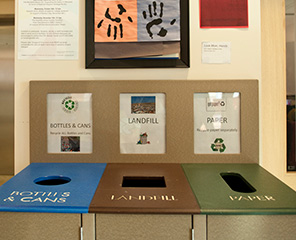Black and Gold? Try Green and Gold
Spend a few minutes in Patapsco Hall’s recently-completed addition, and you won’t have to be told it received one of the world’s top certifications for environmentally-friendly design. The large windows reduce the need for artificial light, the heating and cooling system automatically adjusts to your presence and you won’t have to look far to recycle your soda can.
But while all of those features helped the building earn a LEED Gold certification, perhaps the most innovative part of the building’s design is how it is helping shape the future. That’s because residential life is using the building as an opportunity to educate the campus about sustainability.
“We are committed not only to having facilities and practices that lead to a more sustainable future, but also to educating our residents so that they understand our commitment to sustainability and have opportunities to change the culture firsthand,” said Katie Boone, director of residential life.
Education and leadership on climate change are key underpinnings of the American College and University Presidents Climate Commitment, which President Hrabowski signed in 2007. Within three years, the university adopted a Climate Action Plan, which among other things, requires new construction to meet at least LEED Silver certification.
Patapsco Hall exceeded expectations for certification – and for student involvement. While the addition was still in the earliest stages of planning, residential life invited students to contribute to conversations about making the building environmentally friendly.
“I was primarily concerned with the green design of the project, the energy consumption of the building, ideas for day-lighting as well as energy conservation,” said Samuel Su ’11, biology, who proposed several ideas for building features at the meetings. “Because the project was something outside of the scope of my academic studies, it really presented an opportunity to learn something else through self-study.” Su runs the green living website Verno, which he started with several other UMBC students in 2009.
All student ideas were considered; some, such as elimination of actively-cooled water fountains, were implemented, while others, such as liquid discussant waterfalls, were investigated but proved to be too costly. One of the most innovative ideas came from Olyssa Starry, a graduate student at UMBC at the time, who suggested setting up a permanent experiment on the building’s roof. Building designers incorporated a 600 square foot “green roof” and an identical “white roof” area into the building’s plans, and data are collected from the water that drains from each section of roof.
“Working with them to incorporate research into the design was such a learning process,” said Starry, who is now completing her Ph.D. at the University of Maryland, College Park. “The team did not need a lot of convincing [to implement the plan], and from what I understand that is not typical.”
Starry is using data from the roof as part of her dissertation, a model of green roof hydrology. The data also are available online – and will eventually be displayed on a screen in the Patapsco lobby – creating a valuable resource for students interested in hydrology, said Andy Miller, associate professor of geography and environmental systems.
“Having a monitoring site right here on campus collecting information in real time presents a great educational opportunity,” he said. “It’s always a great advantage for students to be able to get their hands on real data and to see where it came from.”
With more construction and renovation projects on the horizon, the lessons learned through this project will impact the future of sustainability on campus. The next construction project, the apartment community center, will include a green roof, and residential life is looking to harness students’ enthusiasm for sustainability through new programs, such as contests to see who can use the least electricity and a potential geography and environmental systems living/learning community.
“Ultimately,” Boone said, “it is really about partnering with students to engage and educate on sustainable practices.”
(1/30/13)
© 2012 University of Maryland, Baltimore County 1000 Hilltop Circle, Baltimore, MD 21250 410-455-1000

